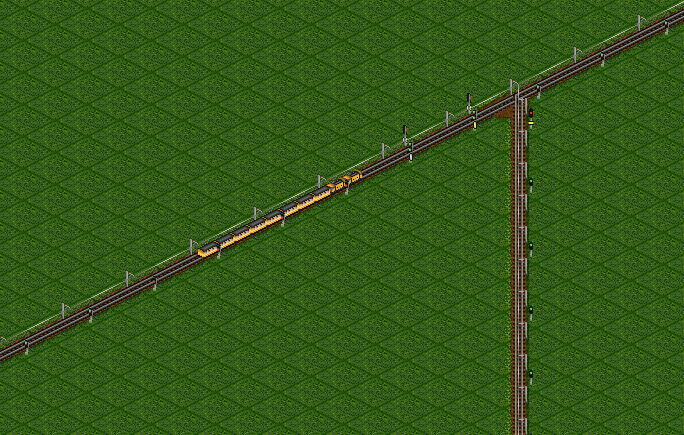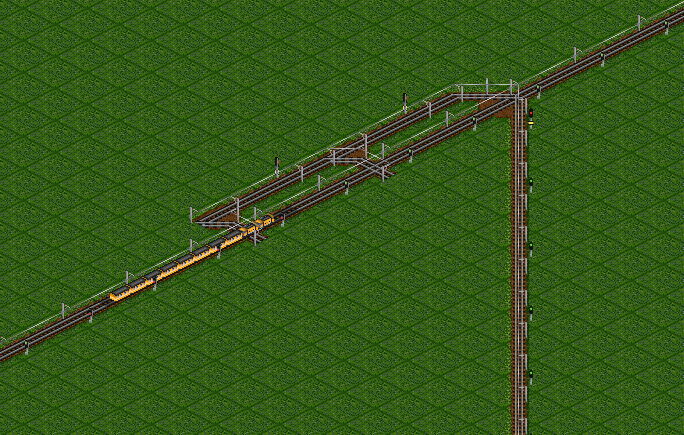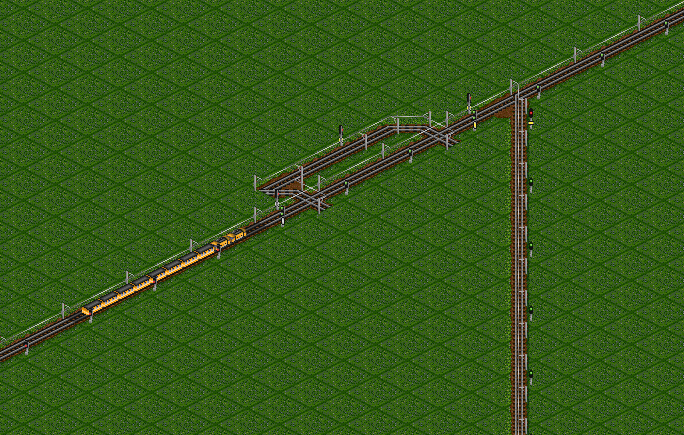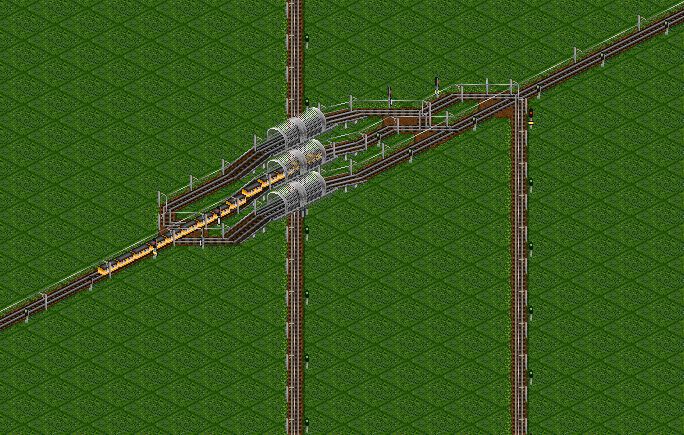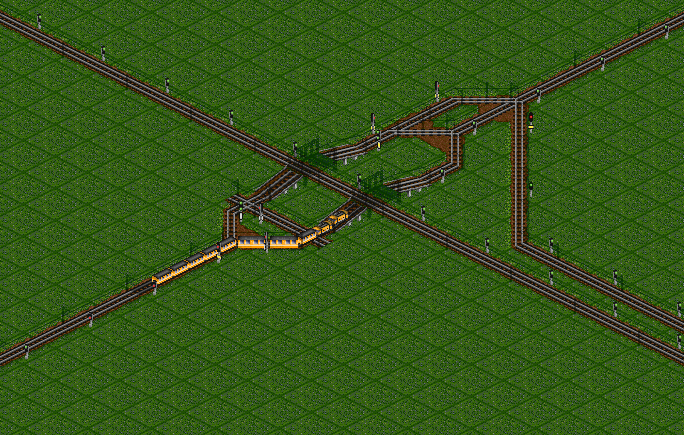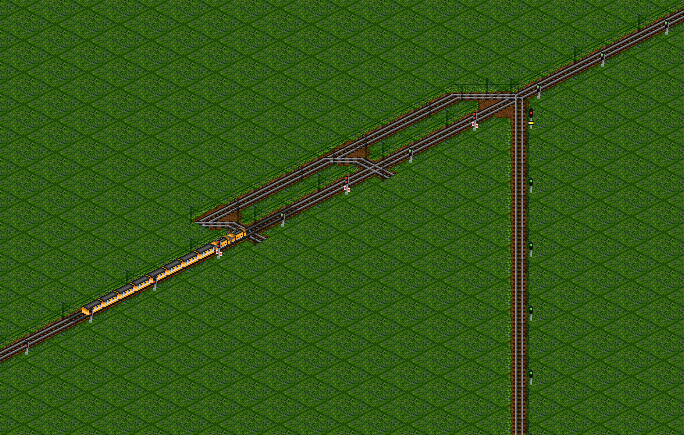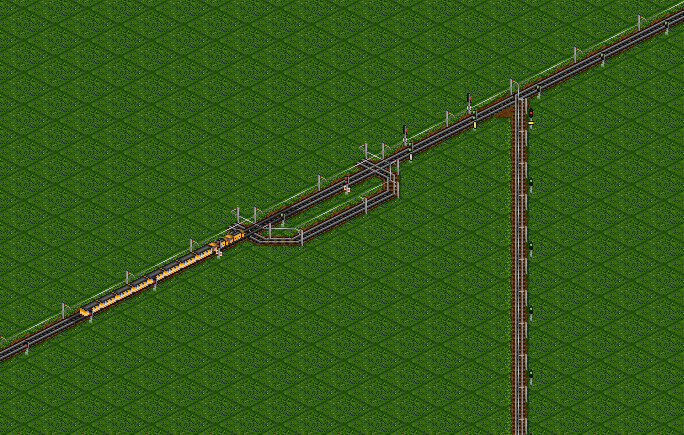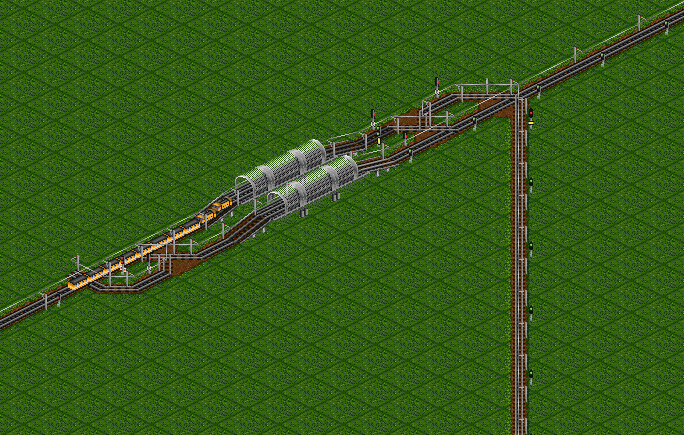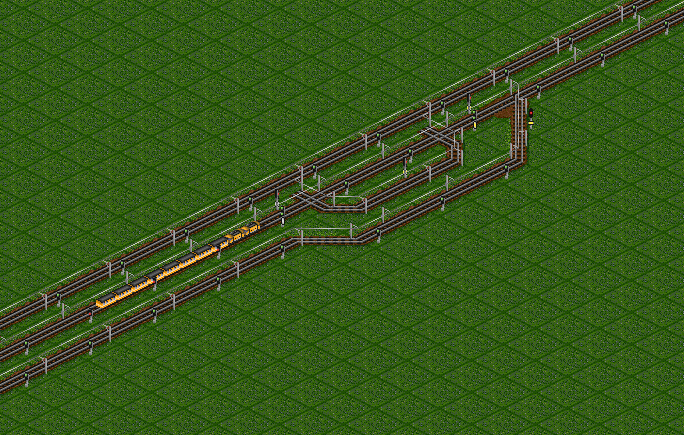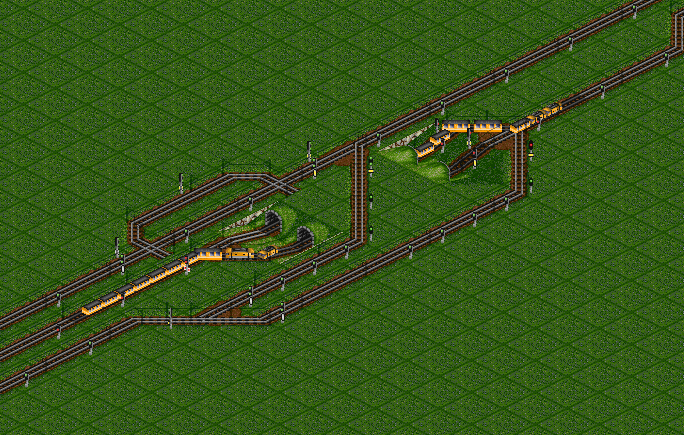Difference between revisions of "Priority"
From #openttdcoop wiki
Resurrection (Talk | contribs) (Adding a point about prios buiduing with limited space) |
m (Small changes, added links/changed some sentences etc) |
||
| (11 intermediate revisions by 6 users not shown) | |||
| Line 1: | Line 1: | ||
| − | Priorities, or prios, are | + | Priorities, or prios, are a type of signal [[Logic|logic]] used in [[Merger|mergers]]. Priorities can be made in many ways, all which will be covered here. |
==Using two-way signals== | ==Using two-way signals== | ||
This is the easiest way to create priority. Use it with care though; when you have multiple two-way combo signals in a row the entire row will be red if one further down the line is, which will cause trains behind the one triggering the prio to stop. This kind of prio should be limited to one combo signal and an exit signal, making it only useful for very short trains or to avoid obstacles in more advanced prios. | This is the easiest way to create priority. Use it with care though; when you have multiple two-way combo signals in a row the entire row will be red if one further down the line is, which will cause trains behind the one triggering the prio to stop. This kind of prio should be limited to one combo signal and an exit signal, making it only useful for very short trains or to avoid obstacles in more advanced prios. | ||
| − | [[File:twoway_prio.PNG| | + | [[File:twoway_prio.PNG|684px|thumb|none|Showing the maximum length a prio of this kind should be]] |
==Standard prios== | ==Standard prios== | ||
| − | This | + | This type of priority can be made infinitely long without causing any delays. It works as follows: a train on the mainline triggers the first of the combo signals on the parallel prio track, which then triggers all combos in the row, effectively making trains on the sideline wait when a train on the mainline is within 9 tiles of the merging point. |
| − | [[File:standard_prio.PNG| | + | [[File:standard_prio.PNG|684px|thumb|none|A standard priority using a parallel track; the most common in our games]] |
Note that you don't actually have to connect the parallel track to every gap between the signals, as long as the gap between the connections is not longer than the shortest trains on the network you're fine. | Note that you don't actually have to connect the parallel track to every gap between the signals, as long as the gap between the connections is not longer than the shortest trains on the network you're fine. | ||
| + | |||
| + | ==Standard prio and two-way signals combined== | ||
| + | If you run out of room, sometimes using two-way signals ''and'' standard priorities is necessary. | ||
| + | |||
| + | [[File:standard_prio_and_two-way.png|684px|thumb|none|A standard prio combined with two-way signals.]] | ||
==Standard prio over a bridge== | ==Standard prio over a bridge== | ||
| − | When you're building compact hubs you | + | When you're building compact hubs you'll often find this trick to come in handy. |
| − | [[File:standard_prio_bridge.PNG| | + | [[File:standard_prio_bridge.PNG|684px|thumb|none|A standard prio over a bridge using a parallel track.]] |
| − | The risk using this construction is that the gap between the connections to the parallel track becomes longer than the train on the mainline, in which case the prio won't trigger. This makes it pretty much un-usable for networks with trainlengths shorter than 4. | + | The risk using this construction is that the gap between the connections to the parallel track becomes longer than the train on the mainline, in which case the prio won't trigger. This makes it pretty much un-usable for networks with [[Train length|trainlengths]] shorter than 4. |
| + | |||
| + | ==Presignal prio over a bridge== | ||
| + | Even though it uses about the same space as standard prio over bridge (mentioned above), it doesn't need third bridge to function and is also friendly to low TLs. | ||
| + | |||
| + | [[File:presig_bridge_prio.png|684px|thumb|none|A presignal prio over a bridge]] | ||
==PBS prio== | ==PBS prio== | ||
| − | PBS introduced some interesting ways to make prios. This prio does exactly the same as the pre-signalled one: | + | [[PBS]] introduced some interesting ways to make prios. This prio does exactly the same as the pre-signalled one: |
| − | [[File:standard_prio_pbs.PNG| | + | [[File:standard_prio_pbs.PNG|684px|thumb|none|A standard 9-tile long PBS prio]] |
| + | |||
| + | ==Combined PBS and presignal prio== | ||
| + | Useful in very tight spaces where twoway signal combined with standard prio is still too large. | ||
| + | |||
| + | [[File:pbs_presig_prio.png|684px|thumb|none|A PBS prio combined with twoway signals]] | ||
==PBS prio over bridge== | ==PBS prio over bridge== | ||
| − | The most interesting prio PBS introduces is the prio over a bridge. Using this technique you don't need a parallel track to have priority over a bridge, also you don't have to worry about the long gap between the connections anymore. | + | The most interesting prio PBS introduces is the prio over a bridge. Using this technique you don't need a parallel track to have priority over a bridge, also you don't have to worry about the long gap between the connections anymore. Don't forget to use twoway signals at bridge exit, because PBS is likely to fail when combining twoway signal with oneway one. |
| + | |||
| + | [[File:pbs_prio_bridge.PNG|684px|thumb|none|Using this mix of PBS and pre-signalling you can have prio over bridges without parallel tracks]] | ||
| + | |||
| + | ==Limited space== | ||
| + | Facing limited space is proverbial daily bread when it comes to joining or merging lines. Here are two examples using knowledge explained above how to build priority while keeping space used at minimum. | ||
| + | |||
| + | [[File:Same side prio.png|684px|thumb|none|Priority built at the same side as the joining track using combo and exit pre-signals on the main track]] | ||
| + | |||
| + | [[File:Used tunnel prio.png|684px|thumb|none|Priority built over used tunnel using PBS and combo pre-signal]] | ||
| − | + | == See also == | |
| − | + | *[[Logic]] | |
| − | + | *[[Two-way Prio]] | |
| − | [[ | + | |
| − | |||
| − | |||
| − | + | ---- | |
| − | [[ | + | [[Oneway_or_Twoway_Presignals|<< Oneway or Twoway Presignals]] | [[Guides:Presignals|^^ Back to Presignals Guides Index]] | [[Balancing|Balancing >>]] |
| + | [[Category:Guides]] | ||
| + | [[Category:Basic networking]] | ||
Latest revision as of 09:40, 17 December 2013
Priorities, or prios, are a type of signal logic used in mergers. Priorities can be made in many ways, all which will be covered here.
Contents
Using two-way signals
This is the easiest way to create priority. Use it with care though; when you have multiple two-way combo signals in a row the entire row will be red if one further down the line is, which will cause trains behind the one triggering the prio to stop. This kind of prio should be limited to one combo signal and an exit signal, making it only useful for very short trains or to avoid obstacles in more advanced prios.
Standard prios
This type of priority can be made infinitely long without causing any delays. It works as follows: a train on the mainline triggers the first of the combo signals on the parallel prio track, which then triggers all combos in the row, effectively making trains on the sideline wait when a train on the mainline is within 9 tiles of the merging point.
Note that you don't actually have to connect the parallel track to every gap between the signals, as long as the gap between the connections is not longer than the shortest trains on the network you're fine.
Standard prio and two-way signals combined
If you run out of room, sometimes using two-way signals and standard priorities is necessary.
Standard prio over a bridge
When you're building compact hubs you'll often find this trick to come in handy.
The risk using this construction is that the gap between the connections to the parallel track becomes longer than the train on the mainline, in which case the prio won't trigger. This makes it pretty much un-usable for networks with trainlengths shorter than 4.
Presignal prio over a bridge
Even though it uses about the same space as standard prio over bridge (mentioned above), it doesn't need third bridge to function and is also friendly to low TLs.
PBS prio
PBS introduced some interesting ways to make prios. This prio does exactly the same as the pre-signalled one:
Combined PBS and presignal prio
Useful in very tight spaces where twoway signal combined with standard prio is still too large.
PBS prio over bridge
The most interesting prio PBS introduces is the prio over a bridge. Using this technique you don't need a parallel track to have priority over a bridge, also you don't have to worry about the long gap between the connections anymore. Don't forget to use twoway signals at bridge exit, because PBS is likely to fail when combining twoway signal with oneway one.
Limited space
Facing limited space is proverbial daily bread when it comes to joining or merging lines. Here are two examples using knowledge explained above how to build priority while keeping space used at minimum.
See also
<< Oneway or Twoway Presignals | ^^ Back to Presignals Guides Index | Balancing >>
